Having a well put acting resume is one of the most important things actors needs to to as soon as they decide to pursue this career.
1. What is An Acting Resume
 If you have ever tried to apply for a job — any kind of job — then you probably know what curriculum vitae is (CV). Acting résumé (or acting CV, whatever you want to call it), is the exact same thing, only tailored to applying specifically for jobs in film, television, stage and commercials (not all showbiz jobs).
If you have ever tried to apply for a job — any kind of job — then you probably know what curriculum vitae is (CV). Acting résumé (or acting CV, whatever you want to call it), is the exact same thing, only tailored to applying specifically for jobs in film, television, stage and commercials (not all showbiz jobs).
Acting resume is probably the first thing you’re going to contribute to your acting career, because it’s easy and it costs nothing. Now whether you have something to put on it or you don’t is a whole different story.
Acting CV is the SECOND thing acting agents, casting directors and other industry professionals will look at (first being your acting headshot). If you pass the first stage of “Does the actor look the part?” based on your headshot, which you pretty much can do nothing about, you then must do your best to strengthen your chances with a professional resume.
While each actor’s resume looks a little different and none of them are identically structured, there are certain patterns that everybody must follow. You can see them in the templates below.
2. What to Put on Your Resume
Obviously, what industry people are looking to find on the resume are:
- How experienced you are
- What kind of acting training you’ve had
- Your measurements and personal information
- Any specific/unique skills that you have
When you’re just starting out in the business, your acting CV will look kind of white. Don’t worry about it, because everybody has to start somewhere. Try and do your best to fill it with anything that’s relevant: think of all the skills you have, any small productions you’ve been involved with. At this point you can even put school plays and workshops.
You might see your resume as not having enough “meat” — and honestly, it probably it doesn’t — but there could be one thing that will catch agent’s eye, and you’ll get called in for an audition. That one thing could be anything, from your height to your ability to balance a pencil on your nose.
3. Acting Resume Structure
So the way your acting CV is actually structured depends on your own preferences. If you Google “acting CV” and go to “Images”, you’ll see that none of them are exactly the same, but they follow a certain pattern.
Here’s the order of things you can use on your resume. Always keep 1-3 at the top in this order, and you can switch 4-6 around:
- Your professional (stage) name
- Union affiliations and agency (if any)
- Personal information and measurements
- Credits, work experience
- Training
- Any specific skills
You can use the American market’s standard structure, which is something that I prefer because it’s less complicated. And you can use the UK’s market structure, where they use a small headshot in the corner, but frankly, I don’t see the point since you’re sending your full-sized headshot alongside the resume anyway.
You can see acting resume template examples to the right. Decide for yourself whichever one you think would work best for you, but either one is acceptable. In my personal experience, professional and SIMPLE always works best.
4. Things to Keep in Mind
Always remember that your acting resume can only be of a SINGLE A4 page.
Once you’re more experienced, drop those credits with less value to keep everything packed on just one page. Once you’re printing these out to hand them over to industry people, and if you follow our advice you might want to staple them to the back of your headshot (this practice is more common in the US market).
Another thing to keep in mind is to avoid putting your date of birth and/or age on your acting CV.
There is absolutely no need for anybody to know how old you actually are before they cast you. In casting people’s eyes, you are as old as you look. More on the reason behind this in a separate article.
And the stapling thing. As an actor, you never leave your home without a batch of acting resumes in your backpack or purse. You never know who you might run into. Once you get the opportunity to hand them over, you will also need your headshot.
To make it easier for you and the person on the receiving end, staple these two together, back-to-back. This will also make sure that your CV goes wherever your headshot goes. Smart!


